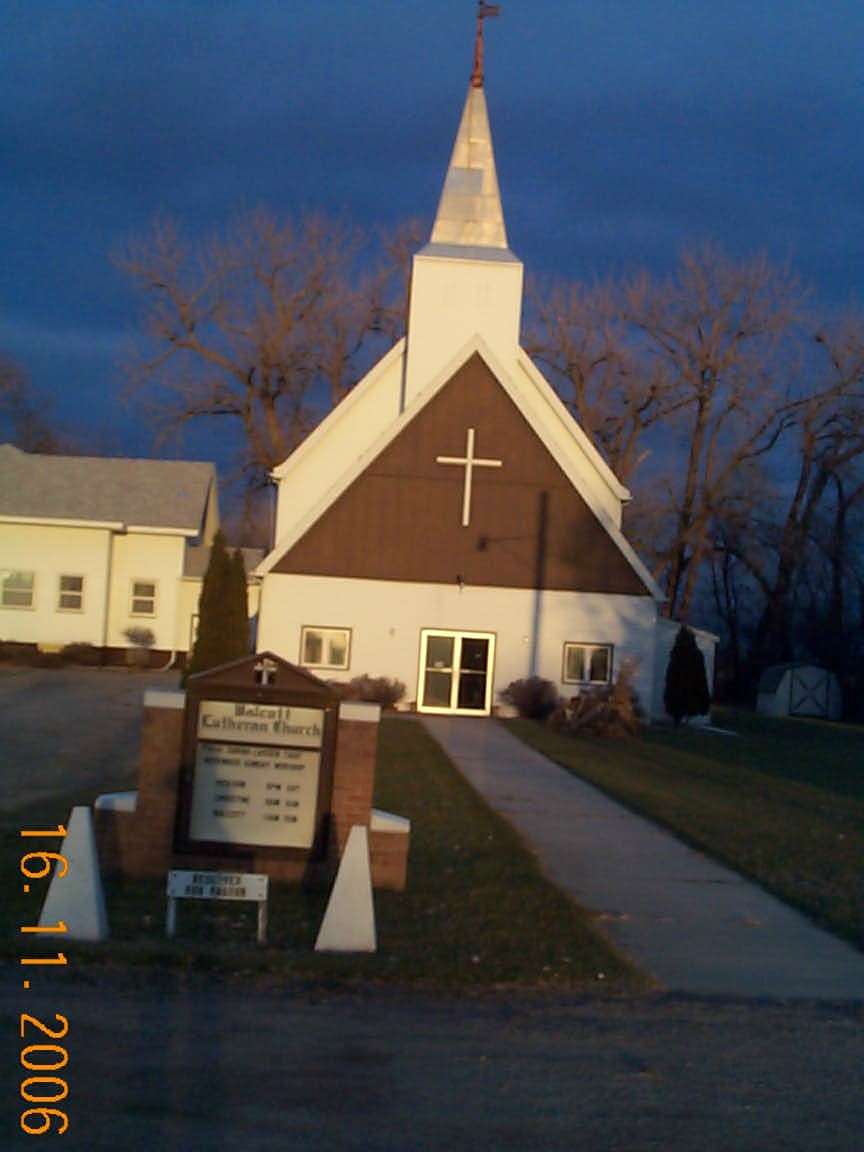WALCOTT LUTHERAN CHURCH
At the end of Main Street

At the end of main street, stands the Walcott Lutheran Church as a tribute to the religious faith of the early settlers. On December 12, 1889, a meeting was held in the Walcott school house to organize a congregation, as a branch of the "Sheyenne Call" (Walcott, Gol, Dovre, Norman, St. John and Christiania), which was named the Walcott Norwegian Lutheran Church, and to call a pastor.
Fourteen men, as the founding fathers, were present and signed their names giving full support: E.O. Ulness, P.R. Thue, T.T. Bendickson, Edw. Peterson, John Nord, Halvor Bakko, Sander Peterson, Nels Bakko, K.G. Hagen, Ole Strand, Asle Amundson, Frank Oppen, Anfin Christianson and Christ Helgeson.
The first pastor was Rev. R.J. Wisnaes who was willing to conduct services every fourth Sunday, as he was also pastor of the Hickson parish.
The district served by this young man covered a large area extending from twelve miles east of Walcott to as far south as Milnor, North Dakota. The cornerstone for the church was laid on June 8, 1898, and the building was completed in 1899 at a cost of $2,964.84. It was dedicated in 1903. On December 4, 1899, Walcott, Gol and Dovre were to constitute a self-sustaining parish, thus ending Rev. Wisnaes' ten years of service as pastor in Walcott.
The first pastor for this three-point parish was Rev. O. Skattebol, who had been a pastor in Gol, Hallingdal, Norway, before coming to America. The Skattebol family presented the congregation with their first organ. Due to poor health, Rev. Skattebol resigned after four and a half years. Our next pastor was Rev. E.O. Ballestad who served faithfully for thirty-one years. His starting salary was $600 plus three offerings, free house and use of thirty acres of land by the parsonage.
Services were conducted in Norwegian, Processional offerings were held on the festive days of the church year, such as Christmas, Easter and Pentecost. For funerals the chancel would be draped in black. The church was heated by two stoves, one on each side of the aisle. If the fires died down during services, the janitor would shake the grates vigorously to revive the flames and maybe jolt some of the parishioners to attention.
Electric lights were added in 1919. In 1926 a coal and wood furnace was installed in the new basement. The church is presently heated with oil. The "Ladies Aid" was organized June 28, 1894, in the home of Mrs. E.O. Ulness. The following were present and joined: Mrs. Ingeborg Amundson, Mrs. A. Tollefson, Mrs. A. Mosand, Mrs. A. Peterson, Mrs. A. Bergeson, Mrs. Halvor Bakko, Mrs. T.N. Hefty, Mrs. H. Trimble, Mrs. Lars Thompson, Mrs. C. Jacobson, Mrs. C. Flaskerud, Miss Letta Olson, Miss Agnes Flaskerud, Mrs. K. G. Hagen and Mrs. O.R. Thue.
As the membership grew, it became too crowded to gather in the homes, so the meetings were held either in the "Cash Store Hall" or the "Opera House". Then in 1926, mainly through the influence of the ladies, a church basement was constructed, and has served as the meeting place since that time.
In 1943 the Walcott Ladies Aid joined the Women's Missionary Federation. In 1961, after the church merger, it was officially changed to American Lutheran Church Women. Projects carried on are quilting, soap making, visiting nursing homes and distributing Christmas baskets. An annual action sale and supper, love offering and food sales bring income for church improvements. The Luther League, first known as the Young Peoples Society, was organized in 1899.
Traditionally they have an ice cream social every summer. At Christmas they trim the tree for the Sunday School. The Lutheran Brotherhood was organized in 1940, and their Lutefisk Suppers are an annual event. In 1957 the Brotherhood bought the Riverside School building, located near the Sheyenne River, and moved it to the church yard in Walcott. It was annexed to the church to be used as an educational unit.
The Sunday School dates back as early as 1889 when it was organized by I.A. Casperson and M.E. Sletmoe. At first classes were held in the church. For a few years classes were held in the public school on Saturday afternoon. During the first week in June, Bible School is offered. The Lutheran Daughters of the Reformation was organized in 1937. They were an active group. Money raised from their bazaars and from selling cook books was given largely to missions.
This organization was discontinued when the Ladies' Aid changed its name to American Lutheran Church Women and included all confirmed girls. In 1896 the congregation acquired land for a cemetery which is located one-half mile south of Walcott. Here were buried the pioneers of this congregation, and it seems fitting that Pastor and Mrs. Ballestad, who spent so many years in this parish, were also laid to rest here. "Sons" of the congregation who have gone into the ministry are Julius E. Farup, Alvin B. Solberg, Percy L. Larson, and Reuben B. Jacobson, Jr. Major church improvements have been realized in recent years.
In 1964 a front entrance to the church proper was built at a cost of $5,100. In 1973 the kitchyen was completely remodeled. A church library continues to grow as books are added. This church still stands on land donated by T.N. Hefty. The parsonage remains where it has always been, on the western edge of town.
The first house was destroyed by fire in 1905. The present parsonage was built the following spring, and remains much the same in appearance, but has undergone remodeling and modernization as needed. Pastors who served after Rev. Ballestad included Rev. O.E. Engebretson, C.F. Turmo, E.T. Fyrand, Ray Lester, Marvin Williamson, Russell Johnson and Kenneth Nehmer.
By Mrs. A.H. Heglie